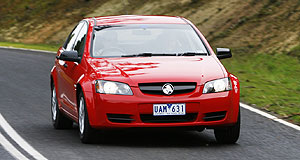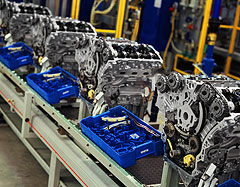
Each way bet: Holden's popular Commodore Omega gets a less powerful, more efficient V6 - but there's no sign of the Active Fuel Management system V8 autos gain from January.
Holden heralds fuel-saving tech for V8 autos, and slips less powerful V6 into market
By MARTON PETTENDY 10 October 2008
Story Source: GoAuto
GM HOLDEN has taken the unusual step of announcing it will introduce General Motors’ fuel-saving Active Fuel Management (AFM) technology on automatic versions of its locally-built V8 models from January next year - in more than three months' time - but it won’t say when its volume-selling V6 models will employ the cylinder deactivation system.
The company used last week’s Australian International Motor Show (AIMS) to reveal that AFM V8-powered versions of the Commodore, Ute, Sportwagon, Statesman and Caprice will join the LPG Commodore and its derivatives, plus diesel-powered passenger cars including the Astra, Epica and (2WD) Captiva, in a new range of “EcoLine” vehicles from Holden in early 2009.
Chairman and managing director Mark Reuss said AFM will be first introduced across the range of eight-cylinder automatics because the Commodore V8’s six-speed auto was already the most fuel-efficient transmission in Holden’s line-up, but he indicated it was unlikely to become available on manual versions.
“AFM has been developed for six-speeds because it’s our most fuel-efficient transmission and if you look at the way AFM works, cylinder deactivation is dependent on throttle position, gear selection and the like. Nobody else offers it with a manual transmission,” he said.
Mr Reuss was less forthcoming when asked when Commodore buyers could expect to see the fuel economy feature on V6 models.
“GM on a technology basis is working on AFM in different cylinder variants, but I’m not going to get into any of our future product plans on anything but V8 today,” he said. Left: Holden V6 engine production.
Left: Holden V6 engine production.
AFM is similar in concept to Chrysler’s Multi-Displacement System (MDS), which debuted the technology here in mainstream models in 2005 via the Chrysler 300C V8 and Jeep Grand Cherokee 5.7, as well as Honda’s Variable Cylinder Management (VCM) system – seen in Australia on the Accord V6 – and Daimler AG’s Active Cylinder Control (ACC).
The Commodore’s AFM-equipped 6.0-litre V8 operates automatically on four cylinders in certain driving conditions until more power is required and is claimed to reduce fuel consumption by up to 1L/100km, but the downside is a three per cent loss of peak power output – about 10kW – compared to the regular V8.
GM offers the AFM system, previously known as Displacement On Demand, on a range of V8 engines in the US, where the Chevrolet Impala’s aged HV-series 3.9-litre V6 also employs it, but says no such technology is currently available on any versions of its Melbourne-built global V6.
Holden has not abandoned its fuel economy push with the Commodore’s 3.6-litre global V6, however, announcing the immediate fitment of the “premium” version of its Alloytec V6 as standard across the Commodore range.
Announced deep within Holden’s AIMS press release, the move sees Omega and Berlina versions of the VE Commodore sedan and Sportwagon, as well as the base Holden Ute, lower their official ADR 81/02 average fuel consumption figure by between 0.2 and 0.4L/100km.
However, while the VE sedan’s official fuel consumption is reduced from 10.8 to 10.6L/100km (its average CO2 emissions similarly drop, from 256 to 252g/km), the entry-level Commodore still falls short of its key rivals in terms of fuel efficiency.
Ford’s entry-level FG Falcon XT returns 10.5L/100km with its standard five-speed automatic and 10.1L/100km with its optional six-speed ZF auto. Toyota’s Aurion V6 returns a class-leading 9.9L/100km at base level.
Meantime, the base Sportwagon models reduce their official fuel consumption figures from 11.1 to 10.7L/100km (CO2 emissions drop from 261 to 256g/km), while V6-powered Holden Utes drop a similar amount - from 11.3 to 10.9L/100km (CO2: 259 v 268g/km).
Crucially, the entry-level Holden V6 now scores the variable exhaust valve timing system of the “High Output” V6 that powers models from the Calais upwards, but it remains mated to GM’s aged four-speed automatic transmission in the Omega and Berlina (and base Ute), which also miss out on premium models’ dual exhaust system.
As such, the “recalibrated” base V6 does not share the 195kW/340Nm performance outputs of the V6 found in premium models, nor even the 180kW and 330Nm peaks of the models they replace.
In fact, with 175kW available at 6500rpm (500rpm higher than before) and 325Nm of torque on tap from 2400rpm (200rpm lower than currently), Holden’s new entry-level V6 offers 5kW and 5Nm less than it did previously.
Now on par with the Commodore’s LPG Alloytec V6, Holden’s revised base petrol V6 is now at a greater performance disadvantage when compared with the Falcon’s 190kW/383Nm 4.0-litre straight six and the Aurion’s 200kW/336Nm 3.5-litre V6, despite remaining less fuel-efficient.
Holden says it remains committed to improving the environmental performance of its volume-selling V6 and is known to be developing a dedicated LPG system to replace its current dual-fuel system. It is expected to match the Duratec V6 LPG engine that will power Ford’s Falcon from mid-2010 by featuring the latest direct liquid injection system.
Holden has also flagged its intention to make available ethanol-compatible versions of the Commodore, as it has with Saab, and Mr Reuss described that vehicle’s hardware as the final piece in its E85 puzzle.
Asked whether Holden would consider investing locally in the same type of ethanol production that is currently being developed in the US, where GM has fostered the manufacture of bio-fuels from household garbage, Mr Reuss said: “Absolutely.
“I would be thoroughly excited if we saw the biotechnology from waste that’s being developed in the US right now cross the ocean into an Australian company and have that capability here.
“I would say we’re not actively looking (to invest) because we’re watching the pilot plant in the US now to see how it goes. (But) We want to play an active role in the establishment of bio-fuels and bio-fuel standards in Australia,” he said.
Monday, October 13, 2008
AFM for V8, not V6
Subscribe to:
Post Comments (Atom)

0 comments:
Post a Comment